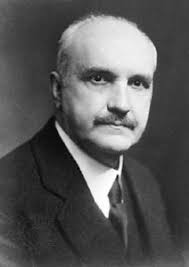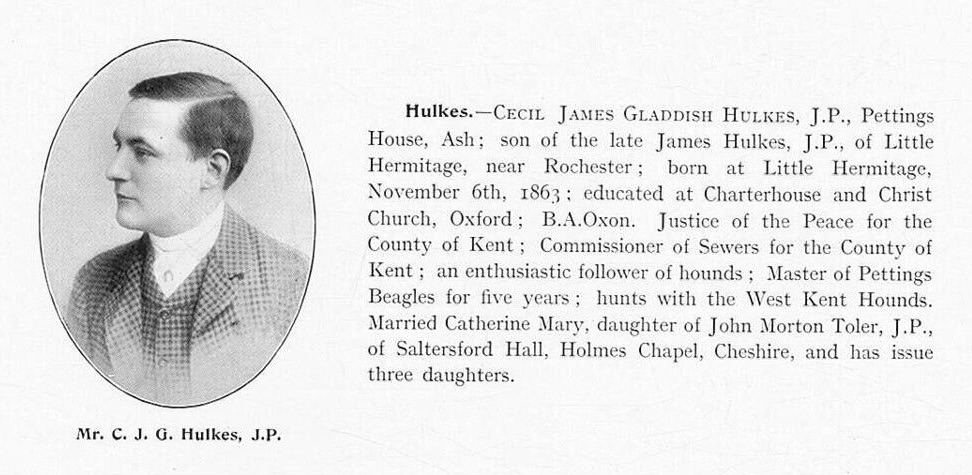This article appeared in the Christmas 2019 edition of Inside Edge, the journal of the Kent Cricket Heritage Trust. From now on, we will reprint several of the most interesting articles from Inside Edge, to give a flavour of the range of activities and interests of the Trust.
Dad id Robertson writes:
One of the most exciting parts of my role as the Club’s honorary curator has been the surprises that have come from time to time through offers of items that owners feel might be of interest and value to the Club’s collection. So it was just three weeks before my retirement at the end of September that I had an email from a lady living in Herefordshire who introduced herself as the granddaughter of W H Patterson, joint club captain with Frank Marchant from 1890-1893.
Known to his intimates as “Harry Pat”, he was regarded for almost twenty years as one of the country’s best batsmen. Following his days as a player he served on the Kent committee, was President in 1922, then Vice-President and Trustee up to the time of his death.

His granddaughter is Mrs Tibb Richardson. She offered to the Club two volumes of beautifully hand written accounts covering Kent’s matches from 1746 up to 1880.
The author of this work is Cecil James Gladdish Hulkes of Little Hermitage, near Rochester. The title page of the first volume reads, “A History of Kent County Cricket from the Earliest Times of which any record remains to the Present Day”. The second volume carries the title “The Omnium Gatherum of Cricket Lore being miscellaneous items of information relating to the game, and more especially those relating to the cricket of the county of Kent.”

There is no indication as to when these works were produced. The final matches recorded were in 1880 and the style of writing suggests it could have been around that time. A report of the Sussex v Kent match of 1825 refers to it as “…a match which still (1885) is productive of great interest….” which brings me to the view that it was probably written in 1885.
The first match, recorded in Frederick Lillywhite’s “Cricket Scores and Biographies” was played at the Artillery Ground, Finsbury Square, London. It came about following a challenge by Lord John Sackville to the All England XII. In a two-innings closely fought game the highest single innings score was that of the All England XI with a total of 70 runs in their second innings. Despite that, Kent was victorious by one wicket. The Author claims it to be the first match of which any record remains and goes on to record that “exactly” 100 years later at Lord’s in the presence of the Prince of Wales, the Duke of Cumberland ad the Duke of Richmond, and at which “many other persons of distinction were present”, England beat Kent by an identical margin.
The Author acknowledges that there is then a gap in recorded matches until 1772 but refers to accounts of several matches having been played during the 26 years in between, “although the scores are not preserved”. The Authority for this claim is Bell’s Life of 23 November 1845 in which it is stated that “….in 1762 or 1765 it is not certain which, 9 men of Dartford with 2 of London beat All England twice.” It goes on, “the first match was played on the Laleham Burnham Ground near Chertsey, Dartford winning by three wickets. The second was played on Dartford Brent.” Included in the England side were Burchwood and Durling of Kent. The Dartford men are listed as Frame, a bowler, John Bell, Wicket-Keeper, Potter, long-stop, Brandon, Thomas Bell, Goldstone, Killick, Stevens and Wakelin.
That season Kent played two matches and won both. The Author also records a single wicket match which Kent won by one wicket and a double wicket match won by two wickets. The first was played at the Royal Artillery Ground and the second at Bishopsbourne Paddock. Players representing Kent were John (or James) Boorman , Joseph Miller, John Wood, Simmons, Richard May, John Frame, Pattenden and Fuggles.
Further matches are recorded for the following three years including what the Author claims to be the first between Kent and Surrey in 1773. The scores are summarised, players listed and results recorded. The venues included Bishopsbourne Paddock, Sevenoaks Vine, the Artillery Ground and Broadhalfpenny Down. In 1774 and 1775 there was no county opposition, all five matches being played against the Hambledon Club. The two in 1774 were two-innings games, both won by Kent with three “given” men whilst of the three in the following year two were double wicket and the other single wicket.
In 1794 we read that Kent “reached a very low ebb…” Of the three games they lost (out of four played) one was against the Oldfield Club, “the only match they played without the assistance of other counties”. This was apparently an exceptional occurrence given that the usual custom was for counties to confine their fixtures to just two non-county clubs, Marylebone and Hambledon. There was apparently a similar situation involving Kent in 1872 when they opposed the newly formed Princes Club and lost, prompting “Scores and Biographies” to say, “A once great Cricket County playing a new club – fallen indeed!”
There is the temptation to continue detailing the fascinating content of this volume but I fear the Editor would not thank me for doing so! As it progresses so it highlights happenings of particular interest to those who follow especially, the history of Kent cricket and which are featured somewhat differently as they might appear in “”Scores and Biographies”. For example, the match against Hampshire in 1790 included the first appearance for Kent of the 4th Earl of Darnley and his brother, the Hon. Edward Bligh. Two years later Cobham, the home of the Bligh family, hosted the Kent v Hampshire match. Our Author updates the information contained in the aforementioned publication. He also lists the year of the first appearance of each Kent player in this match which is subsequently recorded throughout the entire volume.
As the years progress there are more detailed summaries of each season. There are the hand-written summaries of matches, lists of participating players, where the matches were played and brief summaries of the seasons. The early 1800s record the introduction of “Gentlemen’s” matches, accounts of encounters between Kent and England with many familiar names coming to light. As we move towards the middle of the C19th matches against England were increasing in number and those against other counties were being extended further northwards in the first half of the 1800’s. In 1823 against the Marylebone Club a Kent batsman (J. Jordan) recorded the first century for the County, scoring 109 in what was then a high score of 341 with (?) Evans hitting an undefeated 99 [now as recorded 90 — Ed].
The historic 1870 season merits four pages with accounts of the nine games played, a list of all the players who participated in those games and an account of the proceedings that resulted in the formation of Kent County Cricket Club. It also records the death of Fuller Pilch.
Some of the text is taken from Scores and Biographies but quite a lot, especially comments on players and accounts of games, is original.
The two volumes are a valuable addition to the Club’s collection.
0 Comments